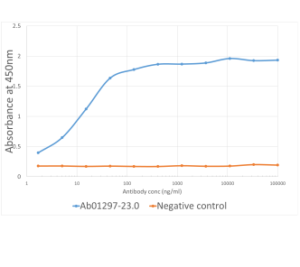
- 关注表位标记
- Primary Antibodies
- Recombinant Antibodies from Human Patients
- Anti-Allergen Antibodies
- 多标签控制蛋白
- Recombinant Isotype Controls
- 抗过敏原抗体
- 重组F4/80克隆CI:A3-1
- 体内研究用重组抗体
- Recombinant F4/80 Clone CI:A3-1
- Research-Grade Biosimilars
- 关注来自人类患者的重组抗体
- 同型对照
- 重组免疫球蛋白Fc结构域(Ig-Fc结构域)
- 人源性重组抗体
- 研究级生物仿制药
- 其他产品
- 抗病毒抗体
- 重组自由轻链
- Antibodies to Epitope Tags
- Anti-Virus Antibodies

UniProt Accession Number of Target Protein: Q3U0X8
Alternative Name(s) of Target: TACTILE; T-cell surface protein tactile; T cell-activated increased late expression proteinImmunogen: This antibody was raised by immunising rats with murine CD96.
Specificity: This antibody is specific for murine CD96, and recognises an epitope in the first Ig domain.
Application Notes: This antibody blocks murine CD96-CD155 interaction, and has been shown to bind to the first Ig domain of CD96 and compete with CD155 binding (Roman Aguilera et al, 2018). This antibody displays significant anti-metastatic activity in four experimental lung metastases models and one spontaneous tumour metastasis model (Roman Aguilera et al, 2018), with a potency greater than the anti-CD96 monoclonal antibodies 3.3 and 8B10. The binding specificity of this antibody has been determined in flow cytometric analysis of HEK-293 cells transfected with a range of CD96 Ig domain chimeric constructs (Roman Aguilera et al, 2018).
Antibody first published in:Seth et al.The murine pan T cell marker CD96 is an adhesion receptor for CD155 and nectin-1.Biochem Biophys Res Commun. 2007 Dec 28;364(4):959-65.PMID:17971293Note on publication:Describes the original generation of this antibody, and its characterisation.


ELISA of anti-CD96 antibody on CD96-Fc fusion protein. Binding curve of the rabbit chimeric version of the anti-CD96 antibody 6A6 (Ab01297; blue line) to an ELISA plate coated with mouse CD96-Fc fusion protein (Pr00230-1.9) at a concentration of 5 µg/ml. A 3-fold serial dilution from 10000 to 1.7 ng/ml was performed using Ab01297-23.0. For signal detection, a 1:4000 dilution of anti-rabbit IgG1 HRP (BioRad) antibody was used.




